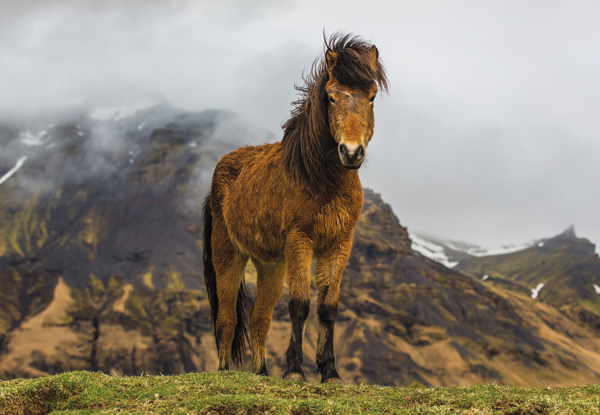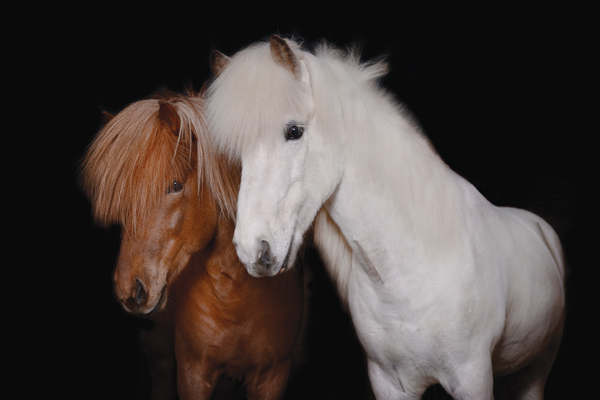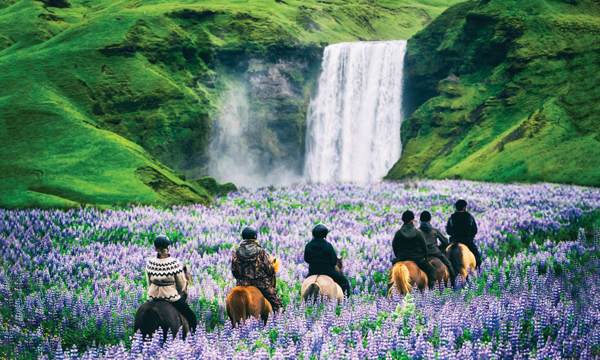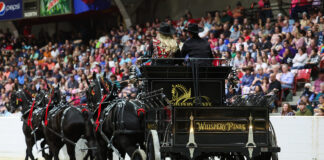
When Viking settlers first came to the island of Iceland in the late 800s, they must have been in awe of its staggering beauty. Huge glaciers, ancient volcanoes, roaring waterfalls and lush forests greeted the immigrant farmers, who brought their animals with them to their new home.

Over the next 1,000 years, horses in Iceland remained isolated from the rest of the world. Without the infusion of outside blood, and with the need to adapt to Iceland’s severe climate and rugged terrain, a distinct breed of horse was formed. Small enough to survive on the sparse native grasses that grow in the coldest winter months, yet strong enough to work the farm and carry an adult rider, the Icelandic breed became an integral part of Icelandic life.
The Icelandic Horses of today are descendants of the horses that survived centuries in this harsh land. Through a law decreed in 982, no horses are allowed to enter Iceland, and horses that leave are never allowed to return. Thus the Icelandic equine gene pool has remained pure for 1,000 years.

Unique Traits
Because of its distinctive history, the Icelandic Horse is truly unique in the equine world. Its long period of isolation, along with careful breeding by Icelanders, has allowed the breed to maintain a classic appearance, movement and temperament.
In addition to its compact form and shaggy mane and tail, the Icelandic possesses special gaits not seen in any other breed. Every Icelandic is born with the ability to walk, trot, canter and gallop like other breeds, and to also perform the four-beat tölt. Some are also born with another gait called the flying pace.

The tölt, the most comfortable of the Icelandic’s gaits, is a lateral movement where at least one foot is always on the ground. The two-beat flying pace is the fastest of the Icelandic’s gaits, with speeds reaching 30 mph. In Iceland, horses are raced at this gait.
The Icelandic Horse’s temperament is as treasured as its distinctive look and special way of going. The ideal Icelandic has a very easy-going personality and is virtually bombproof. The breed’s lack of spookiness goes back to its isolation within its native land where horses have no natural predators.
In Iceland, these horses are an integral part of the country’s tourism industry, providing rides through the spectacular countryside during the warmer months. The horses carry visitors over lava fields and volcanic landscapes, giving a perspective of Iceland you can only get from the back of a horse.

In the USA
Although Icelandic Horses are most numerous in their home country (around 80,000 currently reside in Iceland), 6,248 horses are registered with the United States Icelandic Horse Congress (USIHC). They are valued in the U.S. as pleasure, trail and family horses.
In USIHC-sponsored competitions around the country, the breed is judged at its five gaits using International Federation of Icelandic Horse Associations (FEIF) rules. The FEIF is an association of 19 different countries where the Icelandic Horse is represented, and is the international governing association for the breed.

Every two years, a different FEIF member country hosts the World Championships for Icelandic Horses, where Icelandic Horses from around the globe compete against one another. Throughout the world, the Icelandic Horse is judged on the quality of its five gaits. Classes are organized by division, and include open, intermediate, novice, youth, beginning rider and green horse.
In the U.S., the United States Icelandic Horse Congress has a pleasure/leisure riding department that manages a Sea 2 Shining Sea Ride, which is a virtual ride where members log hours in the goal of traveling through regions of the U.S.
Another virtual competition for all levels of riders is currently being developed to help Icelandic Horse owners stay involved with showing during the COVID-19 shutdown.
The Icelandic is a rugged little horse with great strength, endurance and temperament. As its popularity continues to grow outside its native Iceland, more people are coming to appreciate the beauty and unique talents of this special breed.
Fast Facts about Icelandic HorsesHeight: 13 to 14 hands Color: Primarily brown, bay, black and chestnut; dun, cream, silver, roan and pinto are sometimes seen. Overall Appearance: Rectangular and compact in shape; long, thick mane and tail. Head well-defined, proud and alert. |
Icelandic Resources◆ United States Icelandic Horse Congress |
This article about the Icelandic Horse breed appeared in the July 2020 issue of Horse Illustrated magazine. Click here to subscribe!





